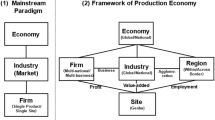Abstract
Companies in high wage countries are increasingly confronted with the challenge of optimizing economies of scope and economies of scale simultaneously to succeed on a global market place. An integrated assessment of production systems facing this challenge is essential to evaluate the actual state of a company and to provide a basis for drawing the right conclusions to reconfigure production systems successfully. In this paper an integrated model for measuring economies of scope as well as economies of scale is introduced, defining the fundamental domains of a production system. The major objectives resulting from the overall scale-scope dilemma are broken down for each domain and the main dimensions for an assessment of each domain are defined. A new measure named Degree of Efficiency is defined, quantifying the fulfillment of the opposing objectives in each domain and hence, the contribution to an overall resolution of the scale-scope dilemma.






Similar content being viewed by others
Notes
In this case equivalent pathways for the isoquants in each domain are sketched which is not necessarily the case for a particular production system.
E.g. an automotive OEM should most likely weight the Product Architecture Flexibility differently in relation to the Product Architecture Commonality compared to a tool making company due to substantially different constraints in market and customer requirements resulting in totally different business models.
References
Porter ME (1998) Competitive strategy. Techniques for analyzing industries and competitors. Free Press, New York
Schmitt R, Vorspel-Rüter M, Wienholdt H (2010) Handhabung von Komplexität in flexiblen Produktionssystemen. Ind Manag 26(1):53–56
Büdenbender W (1991) Ganzheitliche Produktionsplanung und—steuerung. Konzepte für Produktionsunternehmen mit kombinierter kundenanonymer und kundenbezogener Auftragsabwicklung. Springer, Berlin
Schuh G (2006) Produktionsplanung und—steuerung. Grundlagen, Gestaltung und Konzepte, 3rd edn. Springer, Berlin
Schuh G (1989) Gestaltung und Bewertung von Produktvarianten. Ein Beitrag zur systematischen Planung von Serienprodukten. Dissertation, RWTH Aachen
Nyhuis P, Kolakowski M, Heger CL (2005) Evaluation of factory transformability. In: 3rd International CIRP conference on reconfigurable manufacturing, Ann Arbor, 11–12 May 2005
Heina J (1999) Variantenmanagement. Kosten-Nutzen-Bewertung zur Optimierung der Variantenvielfalt. Dissertation, TU Cottbus
Junge M (2004) Controlling modularer Produktfamilien in der Automobilindustrie. Entwicklung und Anwendung der Modularisierungs-Balanced-Scorecard. Dissertation, Univ. Mainz
Förster T (1999) Entwicklung einer Methode zur Bewertung der Wandlungsfähigkeit von Produktionsbereichen für die variantenreiche Serienfertigung. Dissertation, Univ. Magdeburg
Marti M (2007) Complexity management. Optimizing product architectures of industrial products. Dissertation, Univ. St. Gallen
Kohlhase N (1996) Strukturieren und beurteilen von Baukastensystemen. Strategien, Methoden, Instrumente. Dissertation, TU Darmstadt
Erixon G (1998) Modular function deployment. A method for product modularisation. Dissertation, KTH Stockholm
Martin MV (1999) Design for variety. A methodology for developing product platform architectures. Dissertation, Stanford Univ
Rathnow PJ (1993) Integriertes Variantenmanagement. Bestimmung, Realiserung und Sicherung der optimalen Variantenvielfalt, 1st edn. Vandenhoek & Ruprecht, Göttingen
Nyhuis P, Nickel R, Tullius K et al (2008) Globales Varianten-Produktionssystem. Globalisierung mit System, 1st edn. PZH, Garbsen
Kohlhase N (1997) Strukturieren und beurteilen von Baukastensystemen. Strategien, Methoden, Instrumente. Dissertation, TU Darmstadt
Martin MV, Ishii K (1997) Design for variety. Development of complexity indices and design charts. In: ASME design engineering technical conferences, Sacramento, 14–17 Sept 1997
Schuh G, Lenders M, Kupke D, Nußbaum C (2008) Design for changeability. In: ElMaraghy HA (ed) Changeable and reconfigurable manufacturing systems, 1st edn. Springer, London, pp 251–266
Ulrich K (1995) The role of product architecture in the manufacturing firm. Res Policy 24(3):419–440
Westkämper E, Warnecke HJ (2006) Einführung in die Fertigungstechnik, 7th edn. Teubner, Stuttgart
Lindstädt H, Hauser R (2004) Strategische Wirkungsbereiche des Unternehmens. Gabler, Wiesbaden
Stadler H (2008) Supply chain management. An overview. In: Stadtler H, Kilger C (eds) Supply chain management and advanced planning. Springer, Berlin
Chopra S, Meindl P (2010) Supply chain management. Pearson Prentice Hall, Upper Saddle River
Christopher M (2005) Logistics and supply chain management. Financial Times/Prentice Hall, Harlow
Beamon BM (1998) Supply chain design and analysis. Models and methods. Int J Prod Econ 55(3):281–294
Arnold D, Isermann H, Kuhn A, Tempelmeier H, Furmans K (2008) Handbuch Logistik. Springer, Berlin
Supply Chain Council (2009) The supply chain operations reference model. http://www.supply-chain.org
Sürie C, Wagner M (2008) Supply chain analysis. In: Stadtler H, Kilger C (eds) Supply chain management and advanced planning. Springer, Berlin, pp 37–64
Cobb CW, Douglas PH (1928) A theory of production. Am Econ Rev 18(1):139–165
Acknowledgments
The presented results have been developed within the Cluster Domain “Individualized Production” of the Cluster of Excellence “Integrative Production Technology for High-wage Countries” funded by the Deutsche Forschungsgemeinschaft (DFG).
Author information
Authors and Affiliations
Corresponding author
Rights and permissions
About this article
Cite this article
Schuh, G., Arnoscht, J., Bohl, A. et al. Assessment of the scale-scope dilemma in production systems: an integrative approach. Prod. Eng. Res. Devel. 5, 341–350 (2011). https://doi.org/10.1007/s11740-011-0315-0
Received:
Accepted:
Published:
Issue Date:
DOI: https://doi.org/10.1007/s11740-011-0315-0




